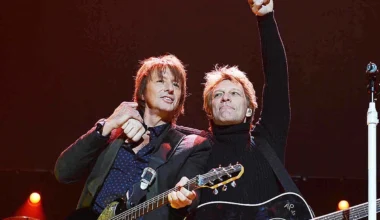Going disco worked out in The Rolling Stones’ favour. While embracing the dancefloor rhythms and syncopated basslines that were popular around the world in the 1970s wasn’t the smartest move for every classic rock dinosaur, the Stones actually made it look easy. That’s because their contribution to the genre was the unmistakable strut of 1978’s ‘Miss You’.
As the Stones’ final number one hit in America, ‘Miss You’ proved that the blues rock greats were as adaptable as any band out there. However, trying to change with the times didn’t always serve the band well. By the mid-1980s, bombastic production styles placed the Stones in a difficult position. Do they attempt to go with the flow or kick back against the glitz and glam of synthpop and pop-rock?
Unfortunately, the Stones attempted to assimilate. 1986’s Dirty Work featured the band at their most confused and easily manipulated. With Keith Richards and Mick Jagger’s relationship at an all-time low, there needed to be some extra support from both within the group and outside their orbit. Ronnie Wood stepped up as an additional songwriter, while producer Steve Lillywhite attempted to keep the Stones ahead of the musical curve.
The results are hilariously dated, but the Stones actually looked to the past for the album’s first single, ‘Harlem Shuffle’. Originally recorded in 1963 by American R&B duo Bob and Earl, ‘Harlem Shuffle’ had been on Richards’ radar for years. It was only during the production of Dirty Work that he was finally able to convince the rest of the band to record it.
“I’ve been trying to get ‘Harlem Shuffle’ on an album, without actually telling Mick, for 5 or 6 years,” Richards revealed in 1986. “I thought that was a natural number for him to sing – it was made for him. I’ve been giving him cassettes with ‘Harlem Shuffle’ stuffed in the middle somewhere for a long time, but I never got any real response. One night we were in the studio and Woody and I started plunking away at it. We were amazed at how simple the song was – about two chords. The band was just warming up on it, jamming, when Mick walked in and started singing. We realised, ‘Yeah’. And we did it in 2 takes. So it paid off eventually, though it cost me a fortune in cassettes.”
“Yeah, it’s an old tune. It’s a pity, but this particular song everyone seemed to go for and, in this kind of business, I think you don’t want to be too subtle, you know,” Jagger claimed that year. “Pete (Townshend) told me this band, the Fine Young Cannibals covered it last year as well. I didn’t know that.” If British new wavers Fine Young Cannibals did cover the track, it never made its way onto any official releases.
“The original version by Bob & Earl had horns on it, straight-ahead soul-disco style. It was probably the first disco record,” Richards added. “It was still the early ’60s when they did it, but the sound and beat were very connectable to that early disco stuff, too.”
“The thing we didn’t want to do was to exactly lift their sound and arrangement by using horns. So we were trying to get a different sound to kink up and follow those parts through, like Chuck Leavell’s synthesiser riff and the mandolin-sounding guitar intro,” Richards claimed. “That came about because the last couple of years I’ve spent a lot of time in Mexico, and believe me, there’s more guitar players down there per square inch than there is even in Rock & Roll Land (laughs). I mean, everybody plays bloody guitar and they’re all damn good at it. And so I re-learned a lot of the old fandango, dzzz-dzzz-dzzz with the fingers, the feathering.”
Check out ‘Harlem Shuffle’ down below.







